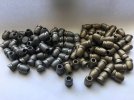burbank.jung
Active Member
I used my MP Mold for the first time today. My plan is mix .22lr range lead into rations of 10:1, 16:1, 20:1 and compare bullet expansion into jugs of water. I don't have much tin. So today I used a few ingots made only from the .22lr range lead and cast around 400 4-160 HP bullets. The weight came out to be 158gr. From what I've been told, this lead may contain 3% Antinomy but no tin. The ingots tested at 10 bhn which is close to 20:1. Here is my question. Is this alloy too soft and will an accuracy load using an alloy with additional tin be that much different? Has anyone cast with indoor range scrap lead that was primarily .22lr lead?

